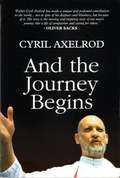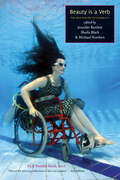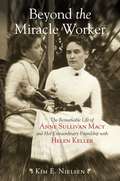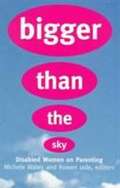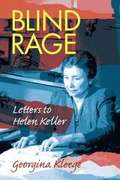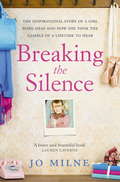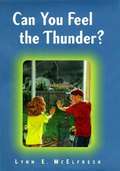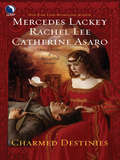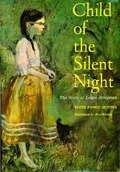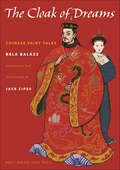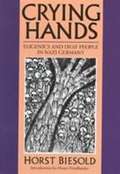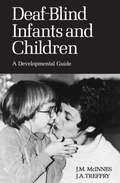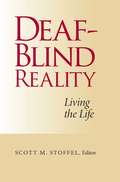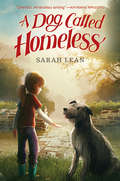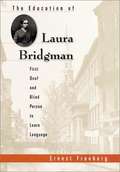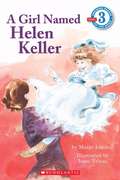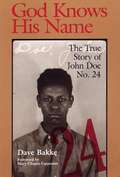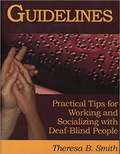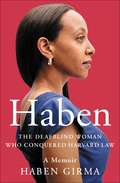Special Collections
Deaf-Blind Special Collection
Description: A collection featuring biographies, fiction and non-fiction by and about members of the deaf-blind community. For books by and about members of the deaf community, visit: https://www.bookshare.org/browse/collection/249852 #disability
- Table View
- List View
And The Journey Begins
by Cyril AxelrodThis life story of deafblind priest, Father Cyril Axelrod, makes compelling reading. A man of such spirituality, humanity, gentleness, compassion, humour, leadership and vision, he has worked tirelessly for others throughout his life and has become a worldwide ambassador for deaf and deafblind people.
He gives a remarkably poignant and tender account of his childhood as the profoundly Deaf child of an orthodox Jewish family in South Africa. He describes the wrenching spiritual journey that follows in his twenties and led him eventually to become a Catholic priest in order to serve deaf people. He tells too of his own painful transition from deafness to deafblindess as his sight deteriorates in middle age as a result of Usher syndrome.
Despite this, his remarkable pastoral work continues, using over eight different indigenous sign languages, in countries as varied as South Africa, Mozambique, Zimbabwe, Australia, USA, China, Singapore, Macau, Ireland, and finally Britain. His work and his love for deaf and deafblind people transcends colour, creed and faith and has been recognised throughout the world.
This is the story of a remarkable man.
Beauty is a Verb
by Sheila Black and Jennifer Bartlett and Michael NorthenChosen by the American Library Association as a 2012 Notable Book in Poetry.
Beauty is a Verb is a ground-breaking anthology of disability poetry, essays on disability, and writings on the poetics of both. Crip Poetry. Disability Poetry. Poems with Disabilities. This is where poetry and disability intersect, overlap, collide and make peace.
Sheila Black is a poet and children's book writer. In 2012, Poet Laureate Philip Levine chose her as a recipient of the Witter Bynner Fellowship.
Disability activist Jennifer Bartlett is a poet and critic with roots in the Language school.
Michael Northen is a poet and the editor of Wordgathering: A Journal of Poetics and Disability.
Beyond the Miracle Worker
by Kim E. NielsenAfter many years, historian and Helen Keller expert Kim Nielsen realized that she, along with other historians and biographers, had failed Anne Sullivan Macy. While Macy is remembered primarily as Helen Keller's teacher and mythologized as a straightforward educational superhero, the real story of this brilliant, complex, and misunderstood woman, who described herself as a "badly constructed human being," has never been completely told.
Beyond the Miracle Worker, the first biography of Macy in nearly fifty years, complicates the typical Helen-Annie "feel good" narrative in surprising ways. By telling the life from Macy's perspective-not Keller's-the biography is the first to put Macy squarely at the center of the story. It presents a new and fascinating tale about a wounded but determined woman and her quest for a successful, meaningful life.
Born in 1866 to poverty-stricken Irish immigrants, the parentless and deserted Macy suffered part of her childhood in the Massachusetts State Almshouse at Tewksbury. Seeking escape, in love with literature, and profoundly stubborn, she successfully fought to gain an education at the Perkins School for the Blind. As an adult, Macy taught Keller, helping the girl realize her immense potential, and Macy's intimate friendship with Keller remained powerful throughout their lives.
Yet as Macy floundered with her own blindness, ill health, and depression, as well as a tumultuous and triangulated marriage, she came to lean on her former student, emotionally, physically, and economically. Based on privately held primary source material, including materials at both the American Foundation for the Blind and the Perkins School for the Blind, Beyond the Miracle Worker is revelatory and absorbing, unraveling one of the best known-and least understood-friendships of the twentieth century.
Bigger than the Sky
by Michele Wates and Rowen JadeIn this anthology the editors gather work by a variety of women with disabilities, united by the theme of parenting. Many contributors write enthusiastically about their parenting experiences; some explain their choice not to raise children; some write about meaningful relationships with children outside the traditional parent role. The authors represent disabilities including blindness, deafness, MS, post-polio, cerebral palsy, and cognitive and psychiatric disabilities.
Bird in the Hand
by Paul HostovskyFrom the book:
Sighted Guide Technique at the
Fine Arts Work Center
In your hands the poems in their Braille versions grow longer, thicker, whiter.
They are giving themselves goose bumps, they are that good. Still they are only as good as themselves.
We are two
people wide
for the purposes of this exercise.
Remembering that is my technique, it's that
simple. Remembering it well is success.
Success is simply paying attention.
Like a poem with very long lines
we appear a little wider, move a little slower
than most of the community of haiku poets
leaping past us with a few right words.
A word about doors: they open
inward or outward, turn
clockwise or counterclockwise, depending
on something that you and I
will probably never grasp.
Doorknobs dance away
and the songs of the common house sparrow
who is everywhere, you say, play in the eaves
as we pass together through the door
to the world,
you holding my elbow,
your elbow and mine making two
triangles trawling the air
for the tunneling, darting, juking, ubiquitous brown birds.
Blind Rage
by Georgina KleegeAs a young blind girl, Georgina Kleege repeatedly heard the refrain, “Why can’t you be more like Helen Keller?” Kleege’s resentment culminates in her book Blind Rage: Letters to Helen Keller, an ingenious examination of the life of this renowned international figure using 21st-century sensibilities.
Kleege’s absorption with Keller originated as an angry response to the ideal of a secular saint, which no real blind or deaf person could ever emulate. However, her investigation into the genuine person revealed that a much more complex set of characters and circumstances shaped Keller’s life.
Blind Rage employs an adroit form of creative nonfiction to review the critical junctures in Keller’s life. The simple facts about Helen Keller are well-known: how Anne Sullivan taught her deaf-blind pupil to communicate and learn; her impressive career as a Radcliffe graduate and author; her countless public appearances in various venues, from cinema to vaudeville, to campaigns for the American Foundation for the Blind. But Kleege delves below the surface to question the perfection of this image.
Through the device of her letters, she challenges Keller to reveal her actual emotions, the real nature of her long relationship with Sullivan, with Sullivan’s husband, and her brief engagement to Peter Fagan.
Kleege’s imaginative dramatization, distinguished by her depiction of Keller’s command of abstract sensations, gradually shifts in perspective from anger to admiration.
Blind Rage criticizes the Helen Keller myth for prolonging an unrealistic model for blind people, yet it appreciates the individual who found a practical way to live despite the restrictions of her myth.
Breaking the Silence
by Jo MilneImagine for a moment that you have never heard the voices of those you love, the music on the radio, the sound of birdsong at dawn nor the persistent passing traffic on the road you walk down. Now imagine that the lips that you have watched moving, the faces that you have smiled at, the words that you read in front of you all slowly start to disappear too. It's hard to comprehend isn't it?Jo Milne had already lived a lifetime surrounded by silence, profoundly deaf from birth, when she began to lose her sight. Just before turning thirty, Jo was diagnosed with Usher Syndrome, a rare genetic and progressive condition that will one day rob her of her sight altogether.Although at this lowest ebb, Jo suffered from deep depression, she has always been determined to live her life to the full. Jo has never let her disabilities affect the way she embraces life however there was always so much that she was missing. In 2014 she made a life-changing decision to undergo major surgery. She had cochlear implants fitted allowing her to hear for the first time. Every moment of Jo's days since the operation has become a journey of discovery.She has been able to hear the voice of her own mother who has stood by her and helped her through some of her darkest moments. She has heard birds sing, people chatting and the sound of children laughing. She is embarking on an incredible journey through four missed generations of music - from the hymns she missed in school assembly to sweeping orchestral performances, from the Beatles and Rolling Stones to the music of this very moment and everything in between. Breaking the Silence is a remarkable and beautifully written memoir that will serve as an inspiration to everyone who reads it. By turns, heart-breaking and heart-warming, it is the incredibly uplifting life-story of a woman who refused to give up hope and always lives life with a smile upon her face.
Can You Feel the Thunder? (First Edition)
by Lynn E. McelfreshThirteen-year-old Mic Parsons struggles with mixed feelings about his deaf and blind sister while at the same time he makes his way through the turmoils of junior high.
Charmed Destinies
by Mercedes Lackey and Catherine Asaro and Rachel LeeThree classic stories of timeless love and tantalizing fantasy. . .
Counting Crows by New York Times bestselling author Mercedes Lackey In Lady Gwynnhwyfar's dark, lonely court, her only ally was noble Sir Atremus, a warrior willing to fight for her honor. But would her powerful spell capture his heart-- or tumble the kingdom into chaos?
Drusilla's Dream by USA TODAY bestselling author Rachel Lee Every night Drusilla Morgan dreamed of courageous and handsome Miles Kennedy. Their quest: to battle evil and find true love. Yet when the sun rose, would Drusilla's fantasy man become a reality?
Moonglow by Nebula Award-winning author Catherine Asaro In a world where kings married for magic, Iris Larkspur was required to wed the prince--despite the spell that kept him deaf, mute and blind. Healing her bridegroom would take a power greater than any she'd ever known--one only two bonded hearts could provide!
Child of the Silent Night
by Edith Fisher HunterThe story of Laura Bridgman, the first deaf and blind child to be taught to communicate with the outside world, some fifty years before Helen Keller. It covers her life before she learned to communicate with the Manual Alphabet and briefly tells about her life afterward.
The Cloak of Dreams
by Béla BalázsIntriguing fairy tales by the librettist of Béla Bartók’s opera Bluebeard’s CastleA man is changed into a flea and must bring his future parents together in order to become human again. A woman convinces a river god to cure her sick son, but the remedy has mixed consequences. A young man must choose whether to be close to his wife's soul or body. And two deaf mutes transcend their physical existence in the garden of dreams. Strange and fantastical, these fairy tales of Béla Balázs (1884-1949), Hungarian writer, film critic, and famous librettist of Bluebeard's Castle, reflect his profound interest in friendship, alienation, and Taoist philosophy. Translated and introduced by Jack Zipes, one of the world's leading authorities on fairy tales, The Cloak of Dreams brings together sixteen of Balázs's unique and haunting stories.Written in 1921, these fairy tales were originally published with twenty images drawn in the Chinese style by painter Mariette Lydis, and this new edition includes a selection of Lydis's brilliant illustrations. Together, the tales and pictures accentuate the motifs and themes that run throughout Balázs's work: wandering protagonists, mysterious woods and mountains, solitude, and magical transformation. His fairy tales express our deepest desires and the hope that, even in the midst of tragedy, we can transcend our difficulties and forge our own destinies.Unusual, wondrous fairy tales that examine the world's cruelties and twists of fate, The Cloak of Dreams will entertain, startle, and intrigue.
Crying Hands
by Horst Biesold and Williams SayersExposes the active collusion with the Nazis of various physicians, administrators, and teachers of the deaf who embraced the Third Reich's eugenics policies. Documents the collusion of deaf leaders, who tried to incorporate all independent deaf groups into one Nazi organization while expelling deaf Jews, and traces resistance against the Third Reich by deaf Germans. Includes personal accounts of some of the 1,215 deaf victims of enforced sterilization, demonstrating the lasting physical and emotional pain of Nazi violations. The author is a retired professor and teacher of deaf students.
Deaf-Blind Infants and Children
by John Mcinnes and J. A. TreffryThis is a comprehensive reference guide for teachers, parents, and paraprofessionals working or living with children who are both deaf and blind. It provides day-to-day guidance and suggestions about techniques and methods for assessing children with multi-sensory deprivation, and for devising programs to help them cope.
Deaf-Blind Interpreting Workbook
by Mary Bauer and Karen Chriest Stueland and Jackie Engler-Morris and Janie Neal and Jelica Nuccio and Cynthia WallaceThis workbook was put together to cover basic Deaf-Blind interpreting techniques. Over the past years, the Seattle Deaf-Blind Community has shaped this class and the workbook has evolved.
Deaf-Blind Reality
by Scott M. StoffelMost stories about disabled people are written for the sake of being inspirational. These stories tend to focus on some achievement, such as sports or academics, but rarely do they give a true and complete view of the challenges individuals must deal with on a daily basis. For example: How does a deaf-blind person interact with hearing-sighted people at a family reunion? How does she shop for groceries? What goes through his mind when he enters a classroom full of non-handicapped peers? These aren't questions you are likely to find answers to while reading that incredible tale of success. They are, however, issues that a deaf-blind person wishes others understood. Deaf-Blind Reality: Living the Life explores what life is really like for persons with a combination of vision and hearing loss, and in a few cases, other disabilities as well. Editor Scott M. Stoffel presents extensive interviews with 12 deaf-blind individuals, including himself, who live around the world, from Missouri to New Zealand, Louisiana to South Africa, and Ohio to England. These contributors each describe their families' reactions and the support they received; their experiences in school and entering adulthood; and how they coped with degeneration, ineffective treatments, and rehabilitation. Each discusses their personal education related to careers, relationships, and communication, including those with cochlear implants. Deaf-Blind Reality offers genuine understanding of the unspectacular but altogether daunting challenges of daily life for deaf-blind people.
Deliverance from Jericho
by Bruce AtchisonImagine being a disabled child, hastily sent to a boarding school hundreds of miles from home, and being kept there for months at a time. This was the fate of most physically and mentally impaired students half a century ago. Intellectuals and government officials once believed that the best way to educate “handicapped youngsters” was to segregate them from the able-bodied population, concentrating those pupils into large institutions.
Deliverance from Jericho: Six Years in a Blind School is the story of Bruce Atchison, one such child. Shuttled between a dysfunctional family and an uncaring asylum, his feelings and experiences are related here in a candid fashion. Through his partially-sighted eyes, readers are given a glimpse beyond the manicured lawns and impressive facades into the daily life of Jericho Hill School for the Deaf and Blind.
The author describes how he and his classmates learned Braille, used an abacus for arithmetic, and played sports, educational aspects which are not generally known to the public. Apart from those differences, school life was basically the same as in other institutes. Jericho had its bullies, its cliques, its out-of-touch administrators, and its deplorable food.
A Dog Called Homeless
by Sarah LeanMy name is Cally Louise Fisher and I haven't spoken for thirty-one days. Talking doesn't always make things happen, however much you want them to. When Cally Fisher sees her dead mother, real as anything, no one believes her. So Cally stops talking - what's the point if no one is listening? The only other living soul who sees Cally's mum is a mysterious wolfhound who always seems to be there when her mum appears. But without a voice, how will Cally convince anyone that her mum is still with them, and how will she ever persuade her Dad that the huge silver-grey dog is their last link with her? An outstandingly assured debut novel from a sparkling new talent.
Winner of the Schneider Family Book Award
The Education Of Laura Bridgman
by Ernest FreebergIn the mid-nineteenth century, Laura Bridgman, a young child from New Hampshire, became one of the most famous women in the world. Philosophers, theologians, and educators hailed her as a miracle, and a vast public followed the intimate details of her life with rapt attention. This girl, all but forgotten today, was the first deaf and blind person ever to learn language. Laura's dark and silent life was transformed when she became the star pupil of the educational crusader Dr. Samuel Gridley Howe. Against the backdrop of an antebellum Boston seething with debates about human nature, programs of moral and educational reform, and battles between conservative and liberal Christians, Freeberg tells this extraordinary tale of mentor and student, scientist and experiment. Under Howe's constant tutelage, Laura voraciously absorbed the world around her, learning to communicate through finger language, as well as to write with confidence. Her remarkable breakthroughs vindicated Howe's faith in the power of education to overcome the most terrible of disabilities. In Howe's hands, Laura's education became an experiment that he hoped would prove his own controversial ideas about the body, mind, and soul. Poignant and hopeful, The Education of Laura Bridgman is both a success story of how a sightless and soundless girl gained contact with an ever-widening world, and also a cautionary tale about the way moral crusades and scientific progress can compromise each other. Anticipating the life of Helen Keller a half-century later, Laura's is a pioneering story of the journey from isolation to accomplishment, as well as a window onto what it means to be human under the most trying conditions.
For Pete's Sake
by Linda VervilleChelsea can't figure out what is wrong with Pete the new pup. He runs into things, can't tell the difference between night and day, can't understand he is getting in trouble. Eventuallly the family discovers that Pete is blind and deaf, and then they realize he is special in spite of his disabilites. For young kids and old too.
From Homer to Helen Keller
by Richard Slayton FrenchFrom Homer to Helen Keller, Homer stands for the greatest achievement of the blind in the times antecedent to their systematic education. He stands for all those bards, many of them blind or blinded, creators of literature and makers of our language, who through ballads, always of great vigor and sometimes of surpassing beauty, have handed down to us the glorious traditions of far-off heroic times.
Miss Keller stands for the supreme achievement of education. The blind claim her, but the deaf can claim her, too, and modern education can claim her more than either--and all humanity claims her with the best claim of all. For she is the epitome of all that is best in humanity, all that is most spiritual; and all this through conscious aim and directed effort, through education in its best sense.
A Girl Named Helen Keller
by Margo LundellRead about the life of a blind and deaf girl who brought hope to other people in the world.
Give Me a Sign, Helen Keller!
by Peter Roop and Connie RoopIn this book, you will find out all about Helen Keller, before she made history.
God Knows His Name
by Dave BakkePolice found John Doe No. 24 in the early morning hours of October 11, 1945, in Jacksonville, Illinois. Unable to communicate, the deaf and mute teenager was labeled "feeble minded" and sentenced by a judge to the nightmarish jumble of the Lincoln State School and Colony in Lincoln. He remained in the Illinois mental health care system for over thirty years and died at the Sharon Oaks Nursing Home in Peoria on November 28, 1993.
The young black man, who later became blind, survived institutionalized hell: beatings, hunger, overcrowding, and the dehumanizing treatment that characterized state institutions through the 1950s. In spite of his environment, he made friends, took on responsibilities, and developed a sense of humor. People who knew him found him remarkable.
Award-winning journalist Dave Bakke reconstructs the life of John Doe No. 24 through research into a half-century of the state mental health system, personal interviews with people who knew him at various points during his life.
Guidelines
by Theresa B. SmithHow does deaf-blindness affect communication? How does one guide a person who is deaf and blind? How does all of this affect the role of the interpreter etc.?
Haben
by Haben GirmaThe incredible life story of Haben Girma, the first Deafblind graduate of Harvard Law School, and her amazing journey from isolation to the world stage.
Haben grew up spending summers with her family in the enchanting Eritrean city of Asmara. There, she discovered courage as she faced off against a bull she couldn't see, and found in herself an abiding strength as she absorbed her parents' harrowing experiences during Eritrea's thirty-year war with Ethiopia. Their refugee story inspired her to embark on a quest for knowledge, traveling the world in search of the secret to belonging. She explored numerous fascinating places, including Mali, where she helped build a school under the scorching Saharan sun. Her many adventures over the years range from the hair-raising to the hilarious.
Haben defines disability as an opportunity for innovation. She learned non-visual techniques for everything from dancing salsa to handling an electric saw. She developed a text-to-braille communication system that created an exciting new way to connect with people. Haben pioneered her way through obstacles, graduated from Harvard Law, and now uses her talents to advocate for people with disabilities.
HABEN takes readers through a thrilling game of blind hide-and-seek in Louisiana, a treacherous climb up an iceberg in Alaska, and a magical moment with President Obama at The White House. Warm, funny, thoughtful, and uplifting, this captivating memoir is a testament to one woman's determination to find the keys to connection.
